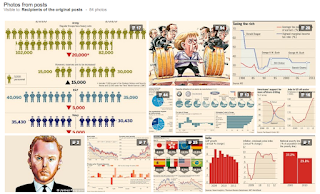When you think of The Financial Times, you might envisage bankers in bowler hats and pinstripes clutching furled umbrellas and a sheaf of pink newsprint. But that’s a pretty dated version of the FT, which is in fact a leading business news and information organization with a hefty digital presence. The average daily print and online readership is 2.2 million, while FT.com has more than 4.5 million registered users.
For the FT, maintaining a leadership position in the dissemination of news and information online has meant a company-wide commitment to encouraging and embracing social media. With this focus on achieving a high-quality social media presence, Google+ was a natural choice for the organization. “We decided to create a Google+ page to add another touch point for our readers,” says FT Community Manager Rebecca Heptinstall. “We want to allow people to read our content where and however they choose.”
In developing its Google+ page, the FT opted to emphasize captivating content and exclusive reporting. As early adopters quickly took to Google+, it might have been easy to just push tech and digital content on the platform, but the FT has gone far beyond this narrow remit, sharing a wide variety of content including a rich stream from correspondents around the world.
Part of the team’s Google+ strategy has also been to play up to the highly visual nature of the platform. Rich media content has been particularly successful. “Google+ is a hugely visual platform for the FT and that is where we see the highest degree of engagement. Whether it’s a video, image or infographic, the interface of Google+ just works well.”
With its combination of rich, unique content and a personalized approach, the FT has reached a significant milestone, recently achieving over 1 million followers -- making their Google+ audience one of the largest and fastest-growing among all newspapers.
“The Financial Times is now read by more different types of people than ever before and Google+ plays a key role in terms of reaching new readers.”
Want to emulate their success? Read the full case study.
Posted by Arlene Lee - Inside AdSense Team
For the FT, maintaining a leadership position in the dissemination of news and information online has meant a company-wide commitment to encouraging and embracing social media. With this focus on achieving a high-quality social media presence, Google+ was a natural choice for the organization. “We decided to create a Google+ page to add another touch point for our readers,” says FT Community Manager Rebecca Heptinstall. “We want to allow people to read our content where and however they choose.”
In developing its Google+ page, the FT opted to emphasize captivating content and exclusive reporting. As early adopters quickly took to Google+, it might have been easy to just push tech and digital content on the platform, but the FT has gone far beyond this narrow remit, sharing a wide variety of content including a rich stream from correspondents around the world.
Part of the team’s Google+ strategy has also been to play up to the highly visual nature of the platform. Rich media content has been particularly successful. “Google+ is a hugely visual platform for the FT and that is where we see the highest degree of engagement. Whether it’s a video, image or infographic, the interface of Google+ just works well.”
With its combination of rich, unique content and a personalized approach, the FT has reached a significant milestone, recently achieving over 1 million followers -- making their Google+ audience one of the largest and fastest-growing among all newspapers.
“The Financial Times is now read by more different types of people than ever before and Google+ plays a key role in terms of reaching new readers.”
Want to emulate their success? Read the full case study.
Posted by Arlene Lee - Inside AdSense Team
















